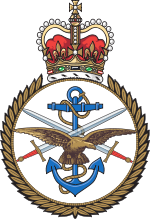History
The post of Colonel SAS (Special Air Service) was created in 1964; this post evolved into Director SAS with the post holder commanding the SAS corps from 1969. [2]
In March 1987, the post of Director SAS became Director Special Forces; it consisted of the Army's Special Air Service, Royal Navy's Special Boat Service and the Army's 14 Intelligence Company under the command of the DSF, who held the rank of brigadier, and with a Deputy, who held the rank of colonel. [2] [3] [4]
During the 2000s, the size of the directorate increased substantially with the inclusion of the Special Forces Support Group and the Joint Special Forces Aviation Wing. Other changes included the 14th Intelligence Company renamed as the Special Reconnaissance Regiment. This was to meet a demand for a special reconnaissance capability identified in the Strategic Defence Review: A New Chapter published in 2002 in response to the 2001 September 11 attacks. [5] Following a review, it was found that the SAS Reserve lacked a clearly defined role, and also stated that the reservists lacked the capability, equipment, and skills to serve alongside the regular special forces. What followed was a reduction in the scope of UK Special Forces. [6] As an outcome of this review, on 1 September 2014, 21 and 23 SAS were removed from the UKSF order of battle [7] and placed with the Honourable Artillery Company (HAC), under the command of 1st Intelligence, Surveillance and Reconnaissance Brigade. [8] [9] This change was partly reversed in 2019 with 21 and 23 SAS returning as an integrated part of the UKSF group. [10]
In 2008, the rank of the DSF was upgraded from brigadier to major-general with the directorate becoming an independent, operational-level component command, alongside Land, Navy and Air elements in the Permanent Joint Headquarters (PJHQ) and in the deployable Joint Force Headquarters (JFHQ). [11] [4]
The DSF is accountable to only the Defence Secretary and the Prime Minister. UKSF may operate in locations where the UK does not formally acknowledge a military presence. [12]
This page is based on this
Wikipedia article Text is available under the
CC BY-SA 4.0 license; additional terms may apply.
Images, videos and audio are available under their respective licenses.
